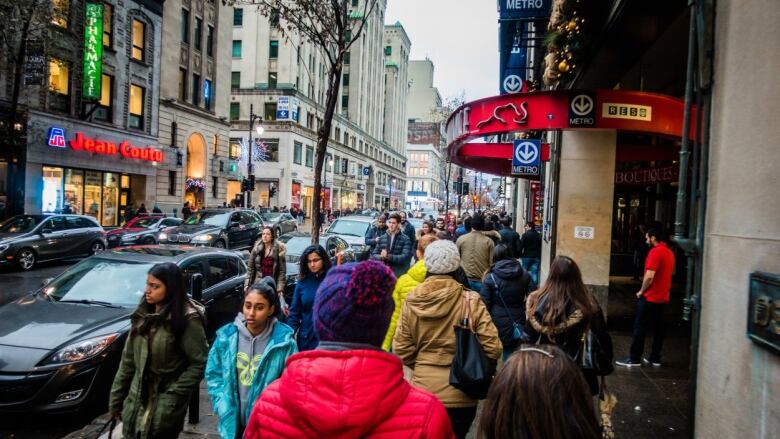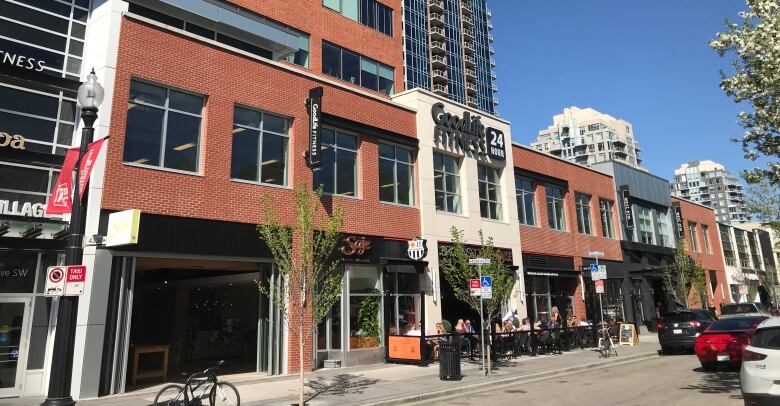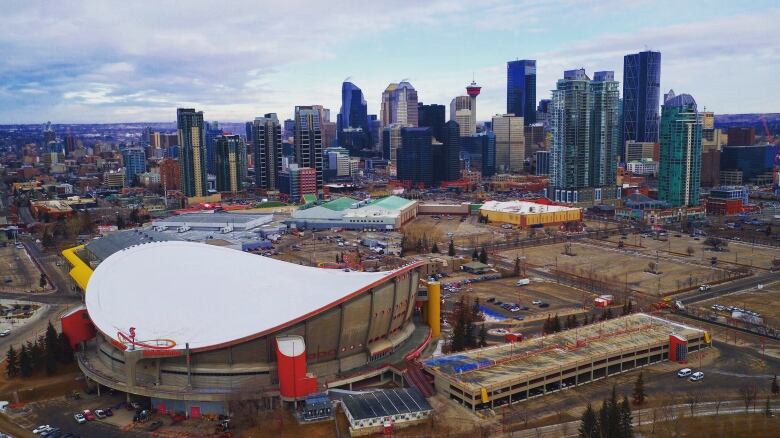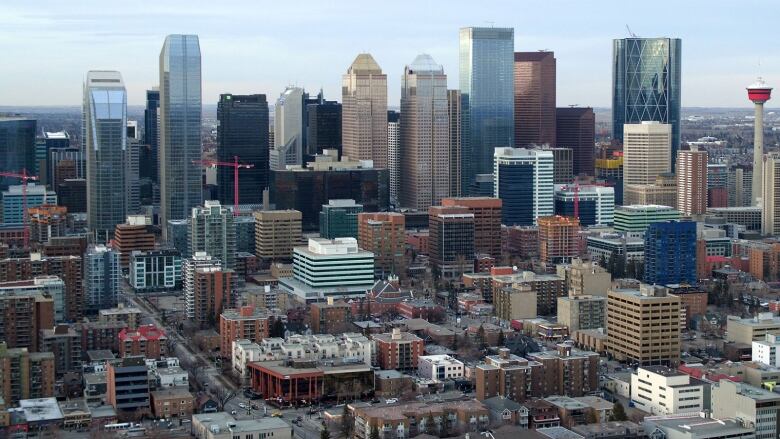We need to fix up 17th Avenue, but we'd better not screw it up
Improving the parts we don't like while preserving the parts we love will be a tricky balance

So, is it time for 17th Avenue to become a "High Street?"
This strip of asphalt lined with shops, bars, coffee shops, a couple empty lots, apartments and condos, runs the gamut from shabby to chic. It's arguably the heart of our city, a key social node and our place to be.
But 17th is pretty much in perpetual flux. Good things come and go. Favourite places appear and disappear. You can buy bondage gear. Then you can't. A bakery pops up and then vanishes a year later. The bars change names and styles but still sling booze.
Right now, 17th is being trenched out for some much-needed infrastructure improvements, but all the new stuff will be buried underground. What has people talking these days is what's happening or should be happening at street level.
There's been enough writing about our primary social hub of late to think perhaps 17th is going through an existential crisis. The avenue is a place because, mostly unconsciously, we think of it as a place. We imbue it with a power in our collective imagination. We want to be there because that's where people want to be.
But it's also a very real place of bricks and mortar. And that's what needs to change.
There are plans upon plans for 17th. There's even a real estate investor who has a vision and is backing it with some serious cash.
So, what's the road ahead for this particular road?
A true High Street
Frank Lonardelli, founder and CEO of Arlington Street Investments, recently announced the firm had purchased 42 buildings along 17th Avenue, from 4th to 14th Street S.W.
That's a heck of a lot of real estate and a pile of cash.
Lonardelli says he'd like to transform 17th Avenue into a High Street something like Vancouver's Robson Street or St. Catherine Street in Montreal.

Now, the British are deeply familiar with the term High Street. It has a connotation for them, sociallyand physically. While the term may not mean much to Calgarians (unless they are Coronation Street fans) let me tell you, in a city with more than its fair share of bland, generic retails streets, it's an idea worth looking at.
We begin.
Evolution and planning
A High Street is usually just that. For towns (many originally built on the tops of hills for security), it was the main street of the community the traditional site for shops, cafes, banks and businesses catering to the ordinary public.
Isn't that what 17th Avenue already is, minus the hill?
I think it is. But it could be better.
Our places, nodes, need to keep up with consumer needs and expectations. As Calgary changes, our expectations of 17th change.

For over 25 years I've wandered and studied the world's streets, from Hong Kong to Berlin. I spent a decade as executive director of the Calgary Downtown Association. I've kicked around Calgary's streets for business and personal pleasure for longer than I can remember.
What I've learned is this: You can design a street and put into place planning documents and proposals. You can make tax modifications, lay new crossroads and add beauty features. You can physically establish the preconditions for vitality.
But as Jane Jacobs, the mid-century guru of urban theory, maintains: Streets also need to be allowed to evolve naturally.
Great streets evolve slowly
To me, the best streets in the world evolve slowly over the years with incremental changes, not by mega-projects that radically transform the street in one fell swoop.
The reason is that, unconsciously, we find it easier to cope with small changes to existing buildings, shops, street corners, trees and benches, rather than the "Hey where did that entire city block go?" stuff that we all know can happen in Calgary.
Jacobs, who literally wrote the book on urban vitality, observed that "good city building is evolutionary not revolutionary." She also maintained that inclusive communities actually have particular ratios.
Yes, get ready for some math.

She called for buildings of a "human scale," meaning four to eight stories tall. She said for a neighbourhood to be vibrant, those buildings need to be divided approximately into thirds: one third new (say, 15 years old or younger), one third middle-aged (about 15 to 50), and one third old (50 years or more.)
Her logic was that this mix results in a diversity of architectural designs, scale of buildings and range of rents this because old buildings tend to have cheaper rents than new ones. It's the range in rents that allows local small businesses to flourish. For Jacobs, and I concur, diversity is more important than density when it comes to creating urban vitality.
Seventeenth Avenue doesn't do too badly in this equation. So, before we bring in the metaphoric wrecking ball, we need to keep this in mind.
At a crossroads
Over the past 40 years, 17th Avenue has evolved from mostly small mom-and-popshops, restaurants and cafes surrounded by mostly smaller homes and apartment blocks, to larger restaurants, sports bars, fancier cafs and high-rise condos.
It has become less a place to shop, more a place to eat and drink.
In 1979, the construction of the mixed-use Mount Royal Villageat the corner of Eighth Street and 16th Avenue S.W. was heralded as the catalyst for transforming 17th Avenue into an international shopping street. While some high-end fashion boutiques and art galleries opened initially, many struggled and eventually left. (Enter the restaurants, bars and fitness centre.)

This illustrates a problem.
All too often we herald a single project as the "necessary revolution," the thing that will kick off the grand transformation. And it doesn't pan out. Then, there is hand wringing and despair. Too much despair can feed into itself, and people stop investing. The revolution stalls.
That said, you've got to start somewhere.
The possible plans
A few years back, the 17th Avenue Business Improvement District rebranded itself from "Uptown 17th"or "17th Avenue Retail Entertainment District." This was done to reflect an evolution from a shopping street to one mixed with cafes, pubs, lounges, bars and restaurants.
Whether anyone noticed the nuance is debatable. But Frank Lonardelli and Arlington Street Investments think it's the right way to go.
Key to his vision: the addition of some upscale shops.
The avenue already has some signature boutique retailers like Brass Monocle, Gravity Pope, Reid's The Stationery Store, Rubaiyat and PURR, and they will soon be joined by a new Arc'teryx store in the old HSBC space.
But while some people immediately thought Lonardelli's idea of a "High Street" meant exclusively high-end shops, and got their knickers in knot, he says that's not what he's looking for.
This is good, because it shouldn't be.A good street needs to offer a mix of high-end stuff and stuff the rest of us can afford.
And whatever17this destined to become, it needs to be geared to everyone.
A weekend pedestrian mall
But while it's a central piece of Calgary geography, 17th Avenue has to deal with a geographic handicap, itself. It exists between two huge shopping centres that have undergone mega-renovations: Chinook Centre and The Core downtown.
Chinook has positioned itself as Calgary's upscale shopping destination with Nordstrom, Saks Fifth Avenue and luxury boutiques like Tiffany, Apple and soon Louis Vuitton. The downtown core offers Hudson's Bay, Holt Renfrew, H&M, Simons and numerous successful boutique fashion retailers.
So 17th will have to offer something different. But what?
Well, in order to get a better idea of Lonardelli's vision, I called him up and asked.
Currently he sees 17th Avenue as a hodge-podge of shops with lots of gaps. And certainly there are some empty storefronts, some empty lots and spaces that could be redeveloped. What he wants to create, really, is a weekend pedestrian mall.

Lonardelli says it would be good to fill in the gaps based on what people want something for people of all ages and backgrounds, day and night, weekends and weekend. This would help avoid the "streets roll up at night" or the "way too rowdy for me" problems.
Back in 2015, Lonardelli himself was quoted in the Calgary Herald as wanting to create a New York Italian market idea, with a cooking school, bakery, wine store and grab-and-go meals all in the same building. This concept fits with Jacobs' idea of a diversity of shops attracting a diversity of user groups at different times of day.
And this is key. We need to plan beyond one shop or one bar as a solution, and encourage mixed developments.
Already, Embassy BOSA and First Capital are doing this. They've teamed up to build The Royal a 34-storey, mixed-use tower with a main floor Urban Fare grocery store, a second floor Canadian Tire and 223 luxury homes.I think this project will be a game changer for 17th.
First, it will add some 400 more people living on the street and two major anchor retailers. Having a grocery store and a hardware store will help create everyday vitality, as they will attract people day and night, seven days a week.
I love streets that offer something for every pocketbook. 17th Avenue needs places like Tubby Dog and McDonald's, just as much as it needs Cibo and Analog Coffee. I love that Reid's Stationery has kitschy party supplies in the front and Mont Blanc pens in the back.
But here's the real challenge. Sure, we can fill up empty storefronts with nifty new things. And we could redevelop existing buildings to create new spaces.
But a big question here: What do we keep?
Sounding the alarm
One of the toughest things to do in city planning is to balance the need to preserve the past while fostering the prosperity of the future.
We have, I think, done a great job of preserving buildings along Stephen Avenue and along Atlantic Avenue in Inglewood and in Kensington. Yet, when I wander 17th Avenue, I don't see a lot of charming historical buildings. (Cue the angry comments under this article.)
When Lonardelli first began to talk about his hopes for 17th Avenue, the Calgary Heritage Initiative (CHI) was quick to respond, saying it was "alarming this could be unfolding without full public transparency."
They estimate there are some 150 buildings along 17th Avenue from Macleod Trail to 14th Street S.W., with 25 being character buildings. They're likely concerned about a 17thAvenue revamp because Arlington has already demolished the 1907 Jalland block a Dutch colonial revival building to make way for its first redevelopment project.
Very disappointing. Jalland Block, @Uptown17th owned by Arlington Street is gone. Also own other #yycheritage buildings #yyc #yychistory pic.twitter.com/YCkGeeF7sw
—@CalgaryHeritageThe new build is a six-storey building with a high-profile tenant on the main floor and 54 boutique condos above.
The CHI also questions how Arlington's ambitions for the avenue fit with the city's urban plan for 17th Avenue. That's a good question.
Our city and various agencies always seem to have an urban plan, or actually five or six plans at once, for any given space at any given moment. Sorting it all out ain't easy.
So I emailed a city planner.
According to urban strategy manager Thom Mahler, the Jalland block redevelopment met all of the city's criteria for development of the site. And Coun. Evan Woolley, who represents the area, told me the Jalland building was "ready to fall down" and was surprised by the CHI's concern.
Mahler said the city is "excited by the redevelopment of 17th Avenue" while Woolley said he's had lots of conversations with Arlington's team about how to enhance the overall area and is confident the developer will work with the community.
OK. So everyone is talking. Check. The infrastructure upgrades, while a pain for drivers, are underway. Check. Seems good so far.
But let's add one more complication here.
Carving out territory
Just east of our hoped-for 17th Avenue pedestrian mall, the Calgary Municipal Land Corporation and Calgary Stampede hope to build a cultural and entertainment district encompassing Victoria Park and Stampede Park.
This district will also be an urban playground for Calgarians pubs, cafes, bars, lounges, shops and hotels as well as a new arena, potentially, and expanded convention centre.
The question becomes: Just how much fun space can one city support? Especially when it's all right next to each other?

One of the key elements of the Vic Park plan is to open up Stampede Park's west entrance to 17th Avenue to allow for pedestrian, vehicle and cycling traffic. So, these two futures would physically intersect. But, it's probably unlikely Calgary can support an urban playground on 17th Avenue S.W. and another along Fourth Street S.E.
It'll be a battle for feet on the ground and pocketbooks. Lonardelli says he knows his 17th Avenue vision must by synergistic with the Vic/Stampede Park vision.
And yet, despite all the plans, all the words and the best of intentions, we are not a planned economy. Spiffing up an avenue means market forces can throw a wrench into things.
High rents kill streets
When areas get cool, with nifty new shops and restaurants, there's always money to be paid. Rent increases. Kaaa-ching!
That means fewer of the independent businesses the odd shops selling funky bits and bobs and run by quirky people can't afford to stick around. National and international chain stores that can pay high rents move in, killing the charm.
Nothing creates higher rents than new buildings where landlords want to recover their investments as fast as they can.
This brings us back to idea that large, upscale revolutionary redevelopment often kills vitality, as only banks, lawyers, financial services, and national and international stores can afford the new buildings. Also, the more exclusive the store, the fewer people who can afford to shop. Fewer people means less vitality.
This is certainly something we will need to avoid with 17th Avenue. It's already a problem as retailers there cope with high rents. Putting up a bunch of fancy new buildings would actually be counterproductive.
Let the great work begin
Jane Jacobs said "you can measure the success of a street by the number of doors that open onto the street."
Jan Gehl, the urban guru responsible for Copenhagen planning, says the quality of a city shouldn't be determined by how many pedestrians you have, but by the number of people who decide to sit down and stay awhile. So, 17th Avenue shouldn't be thought of only in terms of restaurants and shops, but also patios, pocket parks and plazas.
Why does all this matter? Why all the bother over a stretch of road that runs all of 14 blocks in a city that sprawls over some 825 square kilometres?

We return to the idea of a social node.
Seventeenth Avenue isn't just a place to shop or eat. It's a place we come together. It's a place to meet a date or a friend for a beer. It's the place you might hear a new band on a Friday night. It's a place for Calgariansto gather,tomix and mingle, whether they come from the 'burbs for a night in the city or live one block away.
A proper street isn't about geography as much as it's about human geography. That's why we have to get it right.
Call it whatever you like "High Street," "Main Street" or "Red Mile" the success of 17th Avenue S.W. will be measured in how much people want to be there.
This column is an opinion. For more information about our commentary section, please read thiseditor's blogandourFAQ.
Calgary: The Road AheadisCBC Calgary's special focus on our city as we build the city we want the city we need. It'sthe place for possibilities,amarketplace of ideas.Have an idea? Email us at:calgarytheroadahead@cbc.ca













_(720p).jpg)


 OFFICIAL HD MUSIC VIDEO.jpg)
.jpg)



























































































